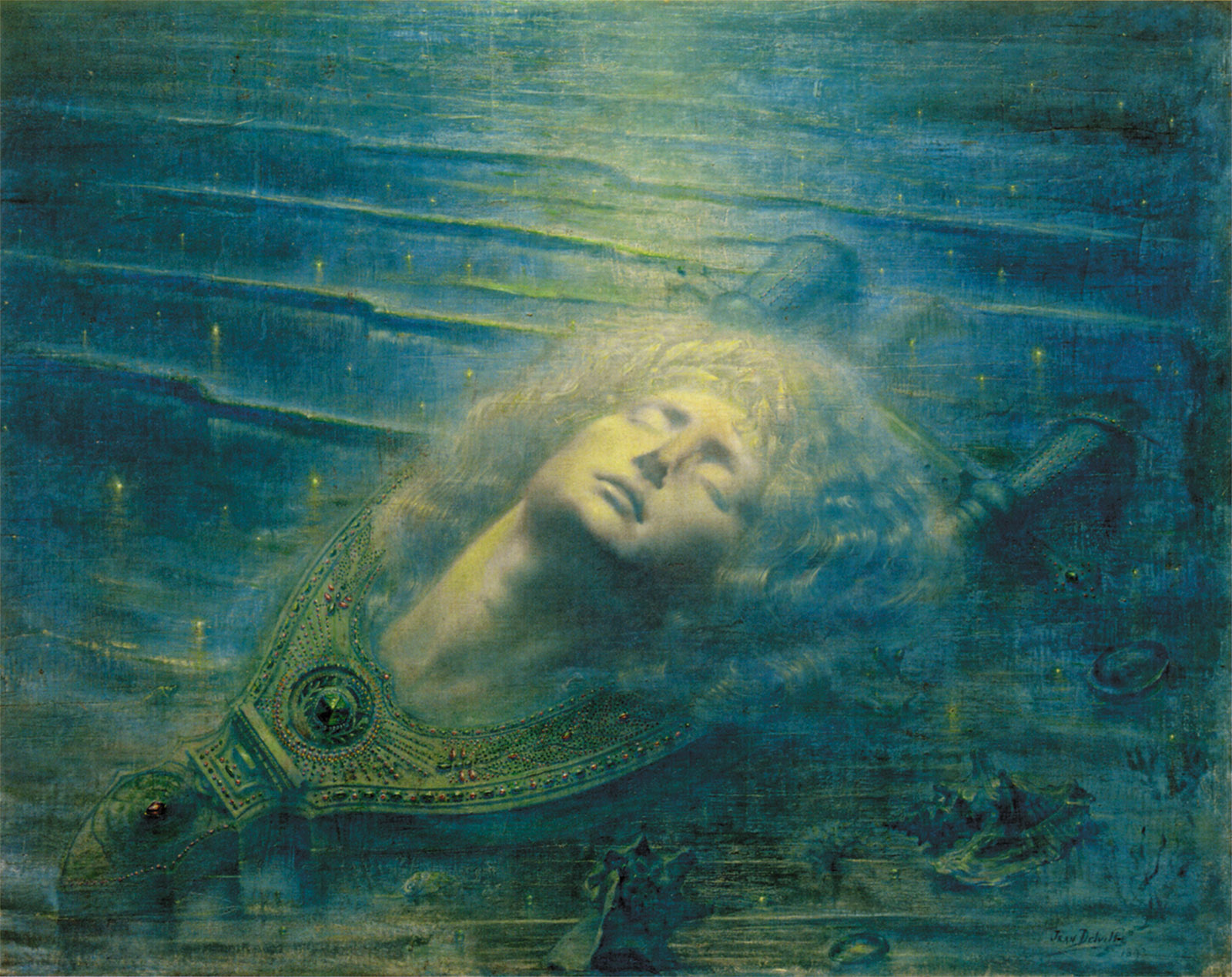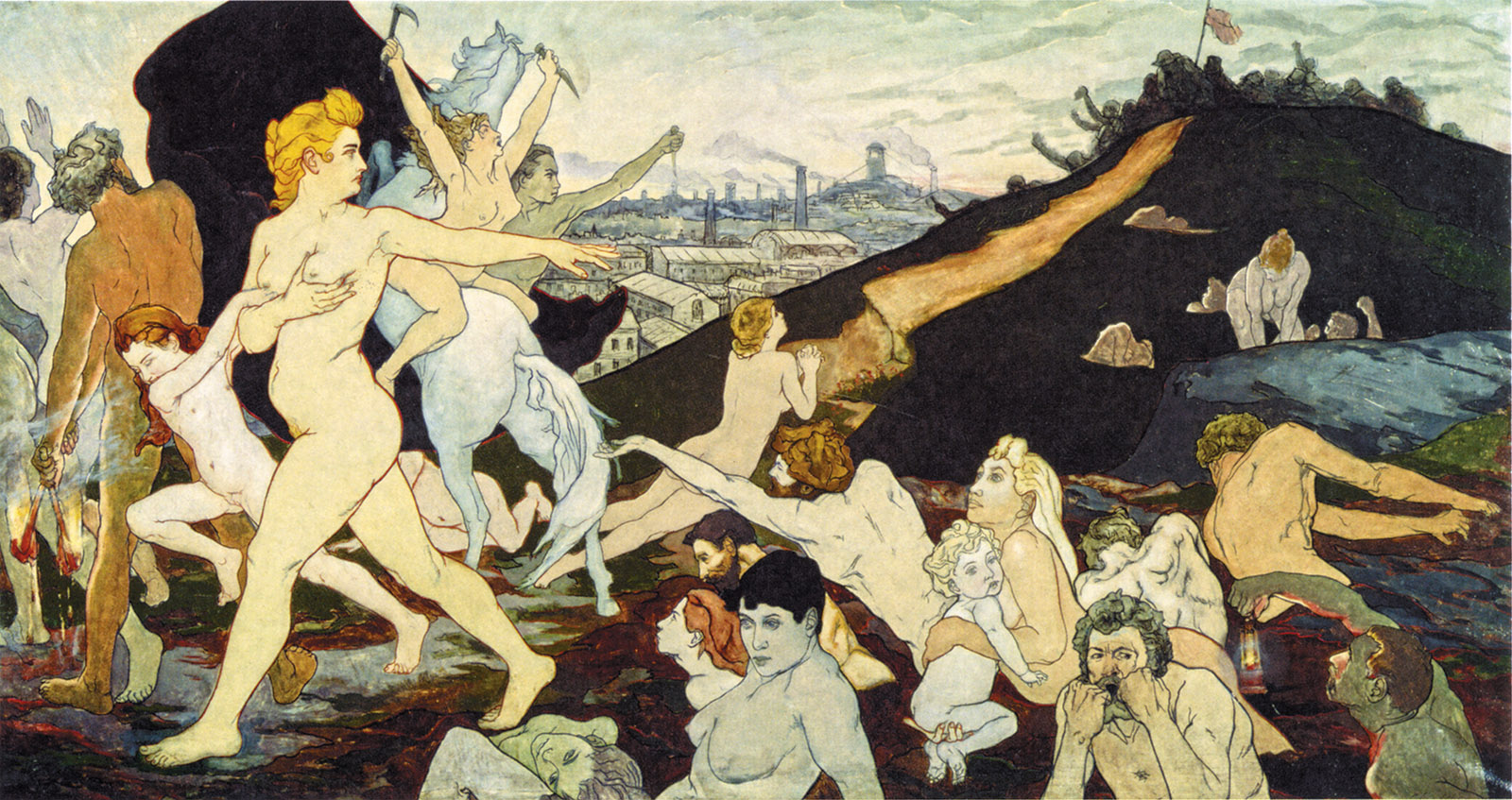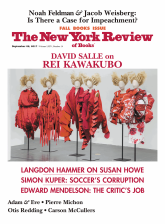There is something somber, spooky, certainly humorless about the salon originally curated by Joséphin Péladan and now recreated in New York’s Guggenheim Museum. Though largely forgotten, this salon of Symbolist painting, sculpture, and graphic and decorative arts was enormously popular in the 1890s and an important step toward the modernist abstraction that was to follow, including the work of such figures as Kandinsky, Malevich, and Mondrian (undoubtedly the reason a museum of modern art like the Guggenheim would be interested in organizing such an exhibition). Symbolism was a movement that rejected concrete reality, science, and positivism in favor of ideas that “are developed into works of art,” as Remy de Gourmont once wrote.
To get a sense of the belief in material progress against which Symbolism was rebelling, we could take a look at a novel, The City and the Mountains, by the Portuguese writer Eça de Queirós, written in the 1890s. The dandified Portuguese hero, Jacinto, born and raised in Paris, tells a rustic Portuguese friend that civilization can exist only in the city:
My super-civilized friend could not even comprehend how nineteenth-century man could possibly savor the delight of living far from the stores employing three thousand cashiers, the markets receiving the produce from the gardens and fields of thirty provinces, the banks clinking with universal gold, the factories frantically spewing out smoke and smart new inventions, the libraries bursting with the paperwork of the centuries, the long miles of streets crisscrossed in all directions by telegraph wires and telephone wires, by gas pipes and sewage pipes, the thunderous lines of buses, trams, carriages, velocipedes, rattletraps, and deluxe coach-and-pairs, and the two million members of its seething wave of humanity, panting as they scrabble to earn their daily bread or under the vain illusion of pleasure.
This is the confident, progressive world the Symbolists were rejecting, the soulless treadmill of urban life.
Although it is difficult to define a particular painting style the salon was encouraging, Péladan (who gave himself the Akkadian royal title “Sâr”) identified many things he was against, including the “theogonies” of “the yellow races,” history paintings, seascapes, landscapes, still lifes, all representations of contemporary private or public life—and of course “all humorous things.” The purpose of his Salon de la Rose+Croix was “to ruin realism” and in its place to “create a school of idealist art.” A striking afterthought: “P.S. Following Magical law, no work by a woman will ever be exhibited or executed” in the salon. Of course some women painters did submit work under male or ambiguous names—and quite a few portraits were done of Péladan himself.
The entire project was inspired as a movement against Impressionism, with its scientific color theories; its interest in everyday life, flowers, beach scenes; its practice of working outdoors rather than in the studio; its inclusion of female painters such as Berthe Morisot and Mary Cassatt; its commitment to observing rather than moralizing. Péladan, by contrast, saw artists as “saints” who “put their hearts full of God into works that are…sublime.”
Péladan was only thirty-four when he began organizing mystical artists. He had grown up as the son of an occultist in Lyons, which was the center of reactionary occultism. His brother became an alchemist and advanced a Taoist-sounding belief that spiritual development depended on never ejaculating. Joséphin was a conservative Catholic who joined a Rosicrucian sect but broke with them over loyalty to the Church (“Outside the Church, no salvation,” Péladan declared, echoing church doctrine). The Rosicrucians were secretive oddballs who traced their origins back to ancient Egypt or sometimes to a fourteenth-century knight called Rosenkrenz; their modern movement, loosely linked to Masons and Theosophists, was revived in 1888 by the Abbé Boullan, who reportedly sacrificed his own newborn baby during a Black Mass.
After Péladan left the Rosicrucians, he established a sect of his own, L’Ordre de la Rose+Croix du Temple et du Graal, and between 1892 and 1897 organized in its name the six exhibitions of art and music from which the Guggenheim exhibition is drawn. Rosicrucianism has always been kept a mystery, but it is a pseudoscience that combines alchemy, the Kabbala, and the interpretation of words and visual symbols. What the mystical Symbolists derived from it was a rejection of real life in favor of an inner, secret meaning, occult yet universal.
Although the mystical Symbolists were misogynistic, they favored androgyny. They saw men as too angular, women as too soft and unstructured; the androgyne was the ideal combination of both. Jean Delville’s wife, for example, is said to have modeled for the face of Orpheus in his The Death of Orpheus (1893) in this exhibition. Orpheus was a popular mythological figure in this period, representing the seer who transcends death, a notion that appealed to the mystical side of the Symbolists (Cocteau was peddling his version of Orpheus into the middle of the twentieth century).
Advertisement
The Symbolists revered Puvis de Chavannes (who executed the murals for the Panthéon in Paris—with their bleached colors, classical scenes, and simple, rhythmic compositions) and Gustave Moreau (who turned his house into a temple of his own art, with thousands of examples full of biblical female sadists like Salomé and Judith and male masochists like the crucified Jesus and Saint Sebastian). These earlier painters had nothing in common in technique but shared a taste for remote subjects. Chavannes stood for a melancholy paganism, whereas Moreau represented a hectic cast of biblical characters.
The late, Polynesian Gauguin was also an inspiration, partly because his images and their written captions were literally symbols, drawn from a mythology approvingly deemed “primitive,” and partly because of his use, after his return from his first Tahiti trip, of woodcuts. This long-forgotten technique, quickly taken up by other Symbolists, reduced the illusionistic details of an image to the bare minimum—flattening perspective and simplifying color—and openly announced its working methods. No longer was an image a creamy imitation of nature but rather the harsh invention of the artist.
The visitor will discover many unfamiliar names among the painters represented at the Guggenheim; some of these will enjoy a revival, based on their originality and talent. The strongest canvases are those by the Swiss painter Ferdinand Hodler (The Disappointed Souls), Jean Delville (The Idol of Perversity), Henri Martin (Young Saint), Alphonse Osbert (Vision), and especially Charles Maurin (The Dawn of Labor). Hodler, usually associated with his mountainscapes, in this instance gives us five defeated-looking men, rendered with Michelangelesque muscularity. Hodler didn’t really have much in common with the others and he may have joined the group as an act of self-promotion. Delville’s Idol of Perversity has a radiant crown, trance-like eyes, dangerously pointy breasts—inarguably a fatal femme fatale. If she is pure evil, then Martin’s and Osbert’s young women are pure peasant good.
Maurin’s painting, the best in the show, is a vast allegory—but of what is not certain (vengeful miners is one possibility). There are many figures in the mysterious Dawn of Labor—including naked men, women, and children. The largest is a woman striding forward, squeezing her own breast, a child clinging to her. Behind her is a woman seated backward on a horse, holding tools that look like a hammer and a dagger. A greenish, full-fleshed woman with her hair in an androgynous bob seems to be rising out of the swamp. The miners in revolt are on the crest of the hill in the background; the red flag they hold aloft was a symbol of anarcho-communism during this period. (See illustration on page 68.)
The Symbolists prized obscurity. The poet Jean Moréas, who first named Symbolism, said “the fundamental nature of symbolic art means never going so far as to conceive directly the Idea itself.” Maurin, like Hodler, was Swiss. He taught Félix Valloton; they were both interested in printmaking, which obviously influenced Maurin’s painting, with its intricate marquetry of detail. He was also under the spell of the painter and poster-maker Toulouse-Lautrec. Like Toulouse-Lautrec, Maurin imitated the way Japanese prints cropped their subjects (as the man gnawing his own hands is truncated at the waist in the lower middle of the vast allegory). Maurin, like other Symbolists (and unlike the Impressionists), was influenced by literature; in subtitles to his mysterious paintings he cited Rimbaud and Baudelaire.
What is clear is that all five paintings listed above present large, bold, unforgettable images and that in all five line predominates over color—none could be accused of recreating everyday reality. No wonder the Sâr declared, “A nightmare out of Poe, that’s art,” and, given all the symbols of evil and sanctity, he announced, “Masterpieces are all religious, even those done by non-believers.” If Impressionism suggests (erroneously) that France is a country of endless sunshine, populated by tender mothers and rosy-cheeked babies and bright flowers or young, happy couples dancing, boating, or picnicking, then mystical Symbolism would have us believe that its images come out of an austere, wintry land of cruel fanatics and decadent royalty. (“Make room for hysteria, make room for neurosis!” declared the first issue of a Symbolist magazine in 1885.)
Péladan was a man of strong opinions. For instance, in one volume called Istar of his twenty-volume novel, Latin Decadence, he berates people from the French provinces as scarcely human compared to the enlightened Parisians:
Advertisement
The provincial never becomes civilized: in his land-owner’s belly he lodges the rudimentary soul of a barbarian. Without meaning to, you disturb his few ideas; and too skeptical to believe in the moral superiority of someone who’s not like him, in not admiring you he will despise you.
Here he sounds like Eça de Queirós, but for opposite reasons; the Sâr is touting the Parisian’s spiritual value, whereas Jacinto feels he is materially advanced.
Péladan was an amazingly prolific author, writing numerous plays and haranguing French publications that ignored or criticized him. When he published his “Novelistic Drama in Five Acts,” The Prince of Byzantium, he was careful to point out—bitterly, one supposes—that it was turned down by the Odéon Theater and by the Comédie-Française, two state-run theaters. Wagner was his idol, whom he ranked with Bach and Beethoven. He published a book on Wagner, giving extensive synopses of all eleven operas, and dedicated it to Judith Gautier, the daughter of the Romantic poet Théophile Gautier and, briefly, Wagner’s mistress. (Her paintings were shown with the Symbolists under a male name.) The Sâr informs us that in Wagner “poetry and music for the first time form a single expression,” which naturally is “androgynous.” To a French archbishop is attributed the remark that the prelude to Lohengrin was brought to earth by angels. The pro-Symbolist Revue wagnérienne, the best of the era’s numerous, short-lived “little magazines,” was published in Paris from 1885 to 1888.
Péladan’s only criticism of Wagner concerns Die Meistersinger, since it is a comedy (“this German realism, a little heavy”): “For an aesthete, comedy is an inferior art.” Of course the summit of Wagner’s art—or anyone’s, Péladan argues—is Parsifal, which Péladan links to the Rosicrucians (the Good Friday Spell from Parsifal is the music playing in the background of the Guggenheim’s exhibition). Much as he admired music, he thought it was inferior to words, which are better suited for rendering ideas. (Péladan contended that Wagner had been led astray by Schopenhauer’s theory that music, being a pure expression of Will, is superior to literature.) In the 1880s and 1890s, Wagnerism had become a religion throughout Europe, much to Nietzsche’s chagrin, the art that had replaced traditional religion. Parsifal even had the Holy Grail and the spear that pierced Christ’s side, Tristan und Isolde had a love philtre, and the Ring Cycle had Nordic heroes, warrior maidens, a magic ring, and the fall of the gods. At the Rose+Croix salon, a fanfare by Erik Satie was performed; Satie also wrote the incidental music for one of Péladan’s plays, though soon enough the two men fell out (perhaps Péladan didn’t at first suspect Satie’s satirical side). Some Symbolists were so taken with music that they gave opus numbers and dynamic markings to their canvases.
Wagner was presented by Péladan and his associates as a cornerstone of Symbolism, especially owing to his idea of a total artwork, Gesamtkunstwerk, one that would combine literature, painting, music, and all the other arts. Certainly his reimagining of mythology, as if it were a living counterpart to our experience rather than a long-forgotten curiosity, had an influence on these pictures of angels, the Holy Grail, demons, and Hades. The idea of the Gesamtkunstwerk may have met a cultural dead end in the 1890s, but it has been successfully revived by Robert Wilson and visual artists like Rebecca Horn, who works with sound, lights, structures, performance art, and poetry.
Decorative arts acquired a new status among the Symbolists. Several of them (like Georges de Feure) went on from making their own ingenious hand-painted picture frames to creating furniture and porcelain in the later Art Nouveau style. Ville Vallgren, also represented at the Guggenheim, designed a funeral urn in bronze. In general, the evolution toward the decorative and ornamental revealed the Symbolists’ interest in what was broadly human rather than quirkily personal, in the tribal rather than the individualistic. (Their figures are rarely recognizable people.) The ban on portraiture and the anecdotal erased the border between painting and decoration, just as it had in classical Muslim interiors and ancient Egyptian tombs. The decorative was no longer subsidiary to the fine art of painting; the two domains blended into each other in what was seen as a triumphant unity.
It seems the pendulum is always swinging back and forth between the idealistic and the realistic, between the spiritual and the material, and in the nineteenth century the two often get intertwined in pseudoscience (mesmerism, phrenology, Lombroso’s positivist criminology, spiritualism). The enthusiasm for science, industry, and invention give way to spirituality, arts and crafts, and medievalism. In the nineteenth century dandyism, decadence, and symbolism were usually associated with reactionary politics, though often the wires got crossed. Huysmans, the author of the bible of decadence, Against the Grain, the very book Dorian Gray is reading in Oscar Wilde’s novel, started out as a naturalist, following the example of Zola, but once he embarked on his “scientifically” documented portrait of his protagonist, Jean Des Esseintes, he was bewitched by his subject and became a Decadent himself (and converted to Catholicism). The poster for the fifth Rose+Croix salon showed a triumphant female figure holding aloft the severed head of Zola, an emblem of the victory of the imagination over documentation.
In America, perhaps because of puritanism, Symbolists avoided femmes fatales, hags from hell, and overactive devils. Nostalgia and dream-like states predominated, a subjectivity made objective, and artists became fascinated by the unconscious. Albert Ryder, for example, seems to have been a genuine American eccentric, mostly immune to outside influences, but he did travel to Europe four times, and his paintings of ships at night and sword-wielding horseback riders do seem an American equivalent to the mystical Symbolists in Belgium, England, and France. The doctrine of “art for art’s sake” and a corresponding rejection of “message” was advanced by Symbolism, an important step toward abstraction.
The Symbolists were associated with Félicien Rops, Edvard Munch, Gustav Klimt, and other major artists. Resistant to industrialization and technology, the end of religion, and the decline of the agricultural past, the Symbolists retreated into the realm of mythology and dreams. Simultaneously, they made advances in the use of photography and printmaking. Though this important show at the Guggenheim, curated by Vivien Greene, seems like a return to the Decadent past, in reality it marks a transition toward modern art.





